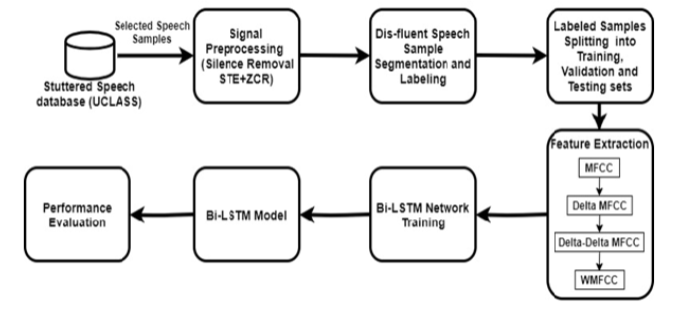


Indian Journal of Science and Technology
Year: 2021, Volume: 14, Issue: 5, Pages: 457-472
Original Article
Sakshi Gupta1*, Ravi S Shukla2, Rajesh K Shukla3
1Department of Computer Science and Engineering, Invertis University, Bareilly, Uttar Pradesh, India
2Department of Computer Science, Saudi Electronic University, Tabuk, Saudi Arabia
3Department of Engineering and Technology, Invertis University, Bareilly, Uttar Pradesh, India
*Corresponding Author
Email: [email protected]
Received Date:24 December 2020, Accepted Date:30 January 2021, Published Date:16 February 2021
Objective: To propose a system for automatic assessment of stuttered speech to help the Speech Language Pathologists during their treatment of a person who stutters. Methods: A novel technique is proposed for automatic assessment of stuttered speech, composed of feature extraction based on Weighted Mel Frequency Cepstral Coefficient and classification using Bi-directional Long-Short Term Memory neural network. It mainly focuses on detecting prolongation and syllable, word, and phrase repetition in stuttered events. Findings: This study has discussed and performed a comparative analysis of WMFCC feature extraction method with different extensions of widely used MFCC, namely, Delta, and Delta-Delta cepstrum. The comparison of speech parameterization techniques is carried out based on the effect of different frame lengths, percentage of window overlapping, and preemphasis filter alpha value. The experimental investigation elucidated that WMFCC outperforms the other feature extraction methods and provides an average recognition accuracy of 96.67%. 14-dimensional WMFCC achieves a low computational overhead compared to conventional 42-dimensional MFCC, including Delta and Delta-delta cepstrum. Application: The integration of Weighted MFCC based speech feature extraction and deep learning Bi-LSTM based classification techniques proposed in this study are more efficient for introducing an optimal model to automatically classify the stuttered events such as prolongation and repetition.
Keywords: Stuttering; MFCC; Delta MFCC; WMFCC; BiLSTM
© 2021 Gupta et al.This is an open access article distributed under the terms of the Creative Commons Attribution License, which permits unrestricted use, distribution, and reproduction in any medium, provided the original author and source are credited. Published By Indian Society for Education and Environment (iSee)
Subscribe now for latest articles and news.